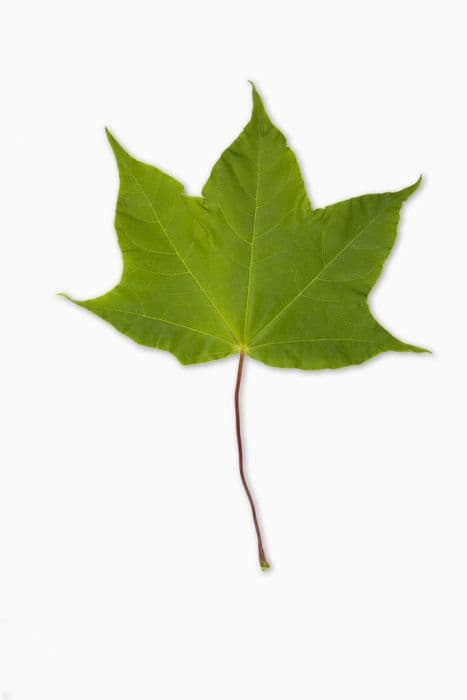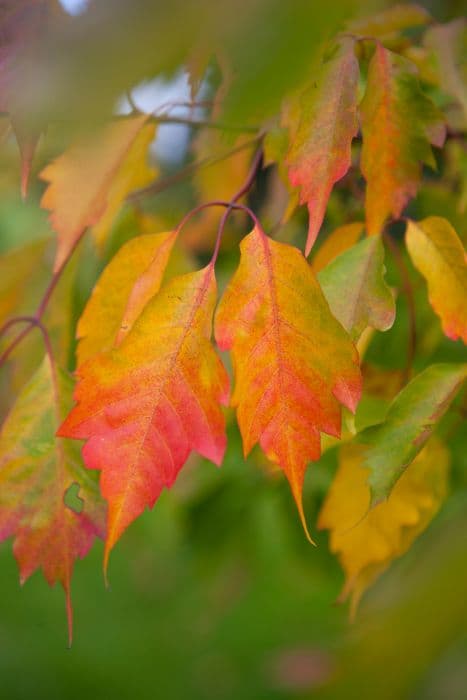Japanese Maple Acer palmatum 'Chishio Improved' (P)

ABOUT
The Japanese maple 'Chishio Improved' is known for its striking and colorful foliage. It exhibits a variety of leaves that change hues with the seasons. In spring, the leaves burst into a vibrant, bright red that can often look like a fiery display of color. As the seasons progress, the leaves transition to a richer green, offering a cooling canopy of lush foliage. Some leaves may retain hints of red along the veins or edges, which creates a beautiful contrast with the green backdrop. The leaves are delicate and finely cut, with each having five to seven pointed lobes, resembling an open hand with fingers spread. This pattern gives the plant a lacy and elegant appearance, adding a soft texture to garden spaces. In autumn, the foliage transforms yet again, putting on a spectacular show with shades ranging from vivid orange to fiery crimson, making it a standout in the fall landscape. The plant's bark, though not as attention-grabbing as its leaves, provides a subtle beauty with its smooth texture and often grayish color that supports the visual appeal of the foliage throughout the year.
About this plant
 Names
NamesFamily
Sapindaceae
Synonyms
Chishio Improved Japanese Maple, Red Japanese Maple, Improved Chishio Japanese Maple
Common names
Acer palmatum 'Chishio Improved'
 Toxicity
ToxicityTo humans
The Japanese Maple is not known to be toxic to humans. There are no common symptoms of poisoning because it is generally considered non-poisonous. Therefore, ingesting parts of this plant is unlikely to have harmful consequences.
To pets
The Japanese Maple is also not known to be toxic to pets. Similar to its effects on humans, there are no specific symptoms of poisoning from this plant because it is typically regarded as non-toxic to animals like cats and dogs. Ingesting parts of the Japanese Maple should not result in harmful consequences for pets.
 Characteristics
CharacteristicsLife cycle
Perennials
Foliage type
Deciduous
Color of leaves
Varies
Height
6 feet (1.8 meters)
Spread
5 feet (1.5 meters)
Plant type
Tree
Hardiness zones
5
Native area
Japan
Benefits
 General Benefits
General Benefits- Aesthetic Appeal: Adds visual interest with its vibrant foliage that changes color with the seasons.
- Landscape Versatility: Suitable for a variety of landscape designs including traditional Japanese gardens and modern settings.
- Small Size: Ideal for smaller gardens and spaces as it does not grow too large.
- Shade Tolerance: Can thrive in partially shaded environments where other plants might struggle.
- Cold Hardy: Capable of withstanding cold temperatures, making it suitable for a range of climates.
- Low Maintenance: Once established, it requires minimal care and upkeep.
 Medical Properties
Medical PropertiesThis plant is not used for medical purposes.
 Air-purifying Qualities
Air-purifying QualitiesThis plant is not specifically known for air purifying qualities.
 Other Uses
Other Uses- The leaves of Japanese Maple can be pressed and used in crafting to create natural art; people often place them in frames or use them for scrapbooking to add an organic touch.
- With its fine, intricate foliage, Japanese Maple branches can be used as natural jewelry displays, giving a unique and rustic way to showcase earrings and necklaces.
- Japanese Maple's colorful leaves can be laminated to make bookmarks, offering a creative and eco-friendly alternative to traditional bookmarks.
- Photographers can utilize Japanese Maple as a subject or backdrop in photography, especially in autumn, to capture the vibrant colors and patterns of the leaves.
- The wood from Japanese Maple, although not commonly used, can be carved into small objects like buttons or beads, showcasing its subtle grain and color variation.
- Fallen leaves from the Japanese Maple can be used in decorative mulches or garden paths, where they contribute to aesthetics as they break down and enrich the soil.
- Harvested branches from pruning can be used in floral arrangements, providing a distinctive, natural look to bouquets and centerpieces.
- The tree can be planted as part of a garden designed to provide habitats and resources for wildlife, offering shelter and food for birds and insects.
- The smooth bark and interesting shape of Japanese Maple branches can be used in terrariums and fairy gardens as miniature natural sculptures.
- The tree's elegant structure can be employed in the practice of bonsai, for those looking for a horticultural challenge and a way to bring the outdoors inside in a miniature form.
Interesting Facts
 Feng Shui
Feng ShuiThe Japanese Maple is not used in Feng Shui practice.
 Zodiac Sign Compitability
Zodiac Sign CompitabilityThe Japanese Maple is not used in astrology practice.
 Plant Symbolism
Plant Symbolism- Beauty and Elegance: The Japanese Maple, commonly referred to as Acer palmatum 'Chishio Improved', is often associated with aesthetic beauty and elegance due to its delicate leaves and stunning fall colors.
- Peace and Tranquility: Its serene presence and the gentle rustling of its leaves in the breeze are symbolic of peace and tranquility.
- Balance and Harmony: The balanced growth and seasonal changes of the Japanese Maple reflect the ideals of balance and harmony in life.
- Endurance and Change: As the Japanese Maple gracefully transitions through the seasons, it symbolizes the capacity to endure change and embrace new beginnings.
 Water
WaterJapanese Maple 'Chishio Improved' should be watered deeply once a week during the growing season, ensuring moisture reaches the roots without waterlogging the soil. During hot or dry spells, increase watering frequency to twice a week. Provide about 1 to 1.5 gallons per watering to sufficiently hydrate the soil around the roots. Reduce watering in the fall and water sparingly in winter, to match the plant's dormant period and prevent root rot. Ensure that the plant is in well-draining soil to avoid excess moisture retention.
 Light
LightJapanese Maple 'Chishio Improved' prefers partial shade to full sun in cooler climates. It thrives best when protected from harsh afternoon sun which can scorch its delicate foliage. A spot with morning sunlight and afternoon shade or filtered light is ideal to maintain vibrant leaf color while avoiding heat stress.
 Temperature
TemperatureJapanese Maple 'Chishio Improved' can survive in a temperature range from 20 to 140 degrees Fahrenheit, but the ideal growing conditions are between 60 and 80 degrees Fahrenheit. They are cold hardy and can tolerate frost but require protection from extreme cold winds and heat.
 Pruning
PruningPrune Japanese Maple 'Chishio Improved' to maintain shape, remove dead or damaged branches, and encourage healthy growth. The best time for pruning is during dormancy in late winter or early spring before new growth starts. Light pruning can also be done in summer to enhance the tree's natural form.
 Cleaning
CleaningAs needed
 Soil
SoilJapanese Maple 'Chishio Improved' thrives in well-draining, consistently moist soil with high organic content. The ideal soil pH for this plant is slightly acidic, around pH 5.5 to 6.5. A mix of loamy soil, peat moss, and perlite or pine bark can create an optimal environment for healthy growth and vibrant foliage.
 Repotting
RepottingJapanese Maple 'Chishio Improved' should be repotted every two to three years to ensure the root system has enough space to grow. Younger trees may need more frequent repotting; however, as they mature, the frequency can decrease. Always repot in the early spring before new growth begins.
 Humidity & Misting
Humidity & MistingJapanese Maple 'Chishio Improved' prefers average humidity levels. While outdoor plants are generally well-suited to the surrounding natural humidity, indoor specimens can benefit from increased humidity especially if the indoor air is dry. Avoid excessively dry environments which might cause leaf scorch.
 Suitable locations
Suitable locationsIndoor
Place Japanese Maple 'Chishio Improved' by a bright window.
Outdoor
Plant in partial shade with protection from harsh sun.
Hardiness zone
5-8 USDA
 Life cycle
Life cycleThe Japanese Maple 'Chishio Improved' begins its life cycle when a seed germinates in early spring, after which the seedling emerges and grows, establishing a small root system. As the seedling develops into a young plant, it produces characteristic palmate leaves, which in the 'Chishio Improved' variety, emerge bright red in spring and mature to green as the season progresses. Over the years, the plant enters a juvenile phase where it grows rapidly, increasing its size and branching structure, eventually maturing and forming a small to medium-sized deciduous tree. This tree reaches reproductive maturity and begins to produce small, inconspicuous flowers in spring, followed by winged samaras (seed pods) that disperse in the environment to give rise to new seedlings. Throughout its life, the 'Chishio Improved' requires seasonal care, including pruning to maintain shape and health, as well as protection from pests and diseases. As a perennial, the Japanese Maple 'Chishio Improved' may live for several decades, going through annual cycles of growth, reproduction, and dormancy in the winter months.
 Propogation
PropogationPropogation time
Late-winter to early-spring
Propogation: The Japanese Maple 'Chishio Improved' can be propagated most effectively through softwood cuttings. This method is commonly employed during the early summer months when new growth is still flexible and hasn't yet matured to wood. To propagate by cuttings, gardeners typically select a healthy shoot that has not flowered, cut it to a length of 4 to 6 inches (10 to 15 centimeters), and remove the leaves from the bottom half of the cutting. The cut end is often dipped in rooting hormone to encourage root development and then placed in a well-draining media such as a mix of peat and perlite. Maintaining consistent moisture and a humid environment, cuttings are placed under indirect but bright light until roots have formed, which can take several weeks. After rooting, cuttings are carefully transplanted to potting soil and grown on until they are strong enough to be moved to their final position in the garden.









